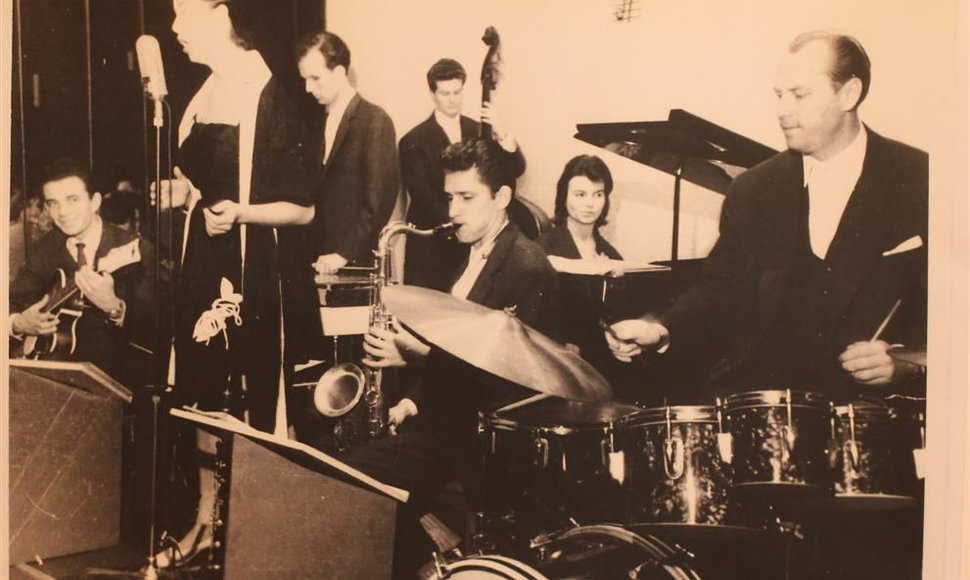It was on one sunny evening of October this year that time seemed to have turned back fifty-odd years. Over forty of the old Kaunas musicians assembled in the city hall. Only a bunch of them still play today, yet their generation has made a crucial, albeit undeservedly forgotten, contribution to the development of Lithuania's modern music scene.
52 musicians gone
“You were the ones who started bringing up generation after generation of new talented musicians,” said one of the organizers of the event Kęstutis Ignatavičius.
The master of ceremonies at Kaunas City Hall, who himself used to play with a big-beat band “Aitvarai”, quoted sad statistics: “I've counted that 52 Kaunas musicians of that generation have already met their maker.” Then, to an accompaniment of a soft piano music, he read all the 52 names.
After a minute's silence, their living colleagues – musicians who used to perform regularly in the cafés, restaurants, and clubs of Kaunas – gave an improvised concert and then concentrated their attention – and talk – on images projected on a big screen.
These were archive photos from the post-war music scene of Kaunas – the unofficial artistic capital at the time, with a more vibrant cultural life than in the more strictly monitored capital of the Lithuanian SSR, Vilnius. Many of the images can be accessed on Kaunasjazz.lt
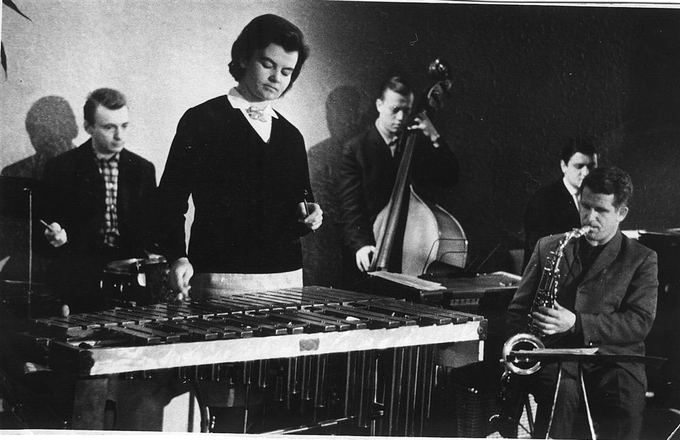 |
| J.Snieškos archyvo nuotr./"Tulip" later became Lithuanian Radio and Television band: Vaičekauskas (percussion), Tiškuvienė-Rekienė (xylophone), Berkus (bass), Borisevičius (saxophone), Grabštas (keys). |
Rock'n'roll makes one sleepy
“Metropolis”, “Tulpė” (“Tulip”), “Orbita” (“Orbit”), “Žaliasis kalnas” (“The Green Mountain”), “Jaunimo kavinė” (“Youth Café”), “Gildija” (“The Guild”), Kaunas Institute of Culture – these are the venues where the assembled musicians used to play. Names of places are easier to remember than names of fellow musicians.
“I cannot recall the name of this guitarist but he used to play with me!” shouted one of the guests. “This is Richie,” someone replied instantaneously.
The exact dates when the photos were taken were equally difficult to identify. “I was still playing in 1964, but I went to serve in the army the following year, so this must be 1965, Palanga,” drummer Jonas Snieška-Sniegas, who has a huge collection of archive images, deduced.
“I'm not giving names, but this guitar player used to say: 'I hate rock'n'roll – it makes one sleepy.' While in fact he simply couldn't play it. His band leader told me so,” former colleagues cheerfully exchanged anecdotes and stories about one another and the parties in Kaunas that were unimaginable without them.
Not all of them went on to become professionals and stars, but thanks to them, Kaunas became the cradle of Lithuania's jazz and pop music.
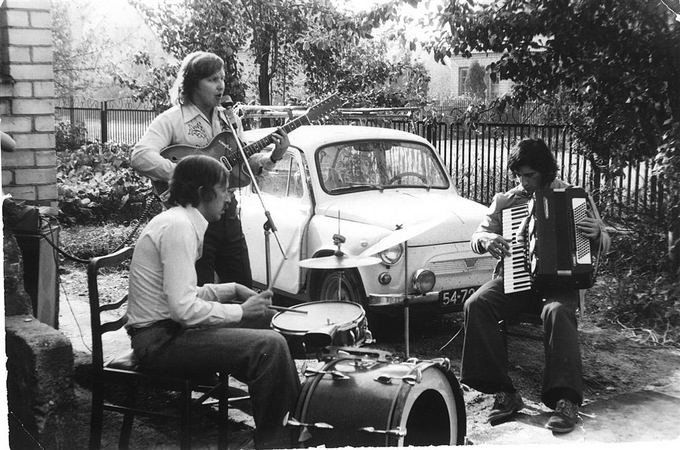 |
| J.Snieškos archyvo nuotr./Players willingly performed at their friends' parties: Snieška (percussion), Teluchinas–Vova (accordeon), Lilys (guitar). |
Imitating tunes on the radio
The beginnings of jazz in Lithuania can be traced back to 1955, when two music enthusiasts, A.Krutulis and J.Matusevičius, set up an orchestra in Kaunas Polytechnic Institute (now Kaunas University of Technology).
At first the band did not have a leader, who could arrange pieces, nor a programme. Musicians would simply try and imitate tunes they heard on the radio.
Therefore the true breakthrough in the history of Lithuanian popular music was in 1956, when the orchestra was joined by Juozas Tiškus who returned after his military service. The new band leader assembled the first professional swing orchestra of 28 musicians in the country: five saxophones, four trumpets, trombones, and a rhythm group – percussions, a double-bass, a guitar.
Tiškus, who was a composer, teacher and could play many instruments, owned a manual recorder which he used to record tunes aired on the radio. He would often “capture” a foreign hit and arrange it for Kaunas Youth Orchestra. In 1966, the orchestra became a basis for light music band “Estradinės melodijos” (“Popular melodies”).
Level of professionalism
One must not neglect to mention other bands that were playing in Kaunas at the time and made significant contributions to the development of Lithuanian jazz and popular music.
Romualdas Grabštas, long-time leader of Kaunas Big Band who passed away three years ago, once confided in the present author that, even though Kaunas could not boast about exceptional jazz figures – like Vilnius-based and internationally acclaimed trio of Viačeslavas Ganelinas, Vladimiras Čekasinas, and Vladimiras Tarasavas – there were many brilliant musicians who lifted the bar for popular music quite high.
The young players used to listen to Western radio stations and recreated the tunes they heard. They would later play them at parties. Kaunas bands – like “Tulpė” or “Orbita” – would play jazz improvisations.
Grabštas, who headed “Tulpė”, says he did not encounter much prohibition or censorship from the authorities. “At least in Kaunas, no one interfered with our playing. We would play much American music with “Tulpė”. I am surprised when people say that the authorities would not allow them to play jazz,” Grabštas said in 2005.
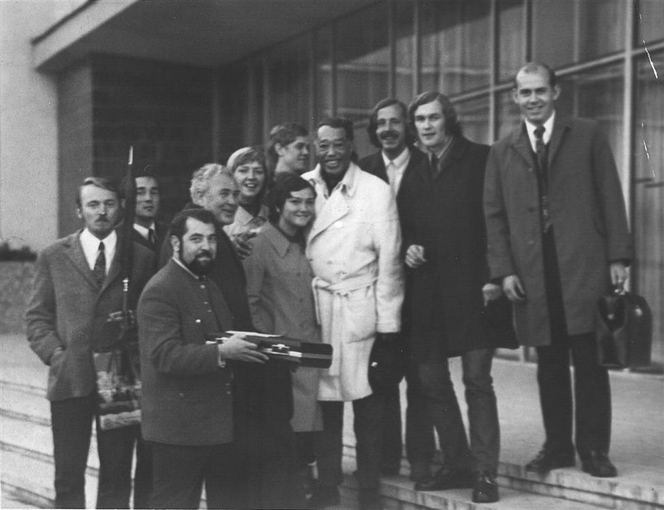 |
| J.Snieškos archyvo nuotr./In 1971, musicians from Kaunas went to Minsk, to see a performance of Duke Elingtono (centre). Elington and Glenn Miller were the greatest influences for Lithuanian jazz musicians. |
From scratch
The post-war generation, keenly interested in modern popular music, had to start nearly from scratch, since no one played jazz in Lithuania between the wars. Jazz, which emerged in the US in the early 20th century, did not come to the country before the 1950s.
Lithuanian military orchestras from the 1930s would only play classical tunes, while musicians at legendary night spots of Kaunas – “Metropolis”, “Versalis” (renamed “Youth Café” in the Soviet era), “Konrado” café – preferred operettas and Schlagers, violin was the dominant instrument.
Players at inter-war restaurants did not improvise as there were simply no musicians able to write instrumentations and arrange pieces. There was a lack of theoretical knowledge, as the first music school in the country opened as late as 1923.
Old generation failed to adapt
The new post-war generation did not mind playing together with colleagues from the old guard, yet the cooperation was not always successful, as looser popular and jazzy tunes would not catch on with “Smetona-era” professionals.
Meanwhile the guests at Kaunas City Hall, representing more than one post-war generation, played together in perfect sync. A lay listener could hardly tell they had not been rehearsing.
“We are all familiar with the same standards, same tunes, therefore playing together is not a problem,” said Ignatavičius, a guitar in his arms. He hinted that there were plans to set up a Lithuanian jazz museum.
It is interesting that people who introduced the new styles to the Lithuanian public did not at first call the music they played “jazz”. They discovered the name later, when they saw “Sun Valley Serenade”, a movie featuring music by Glen Miller.
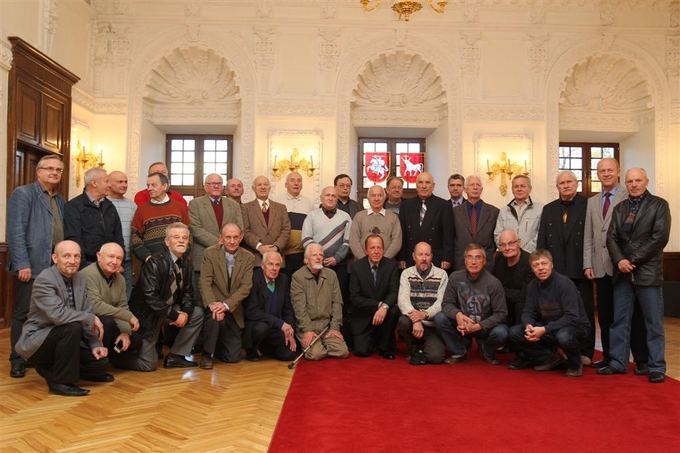 |
| Eriko Ovčarenko/15min.lt nuotr./Jazz musicians now, in Kaunas City Hall |
